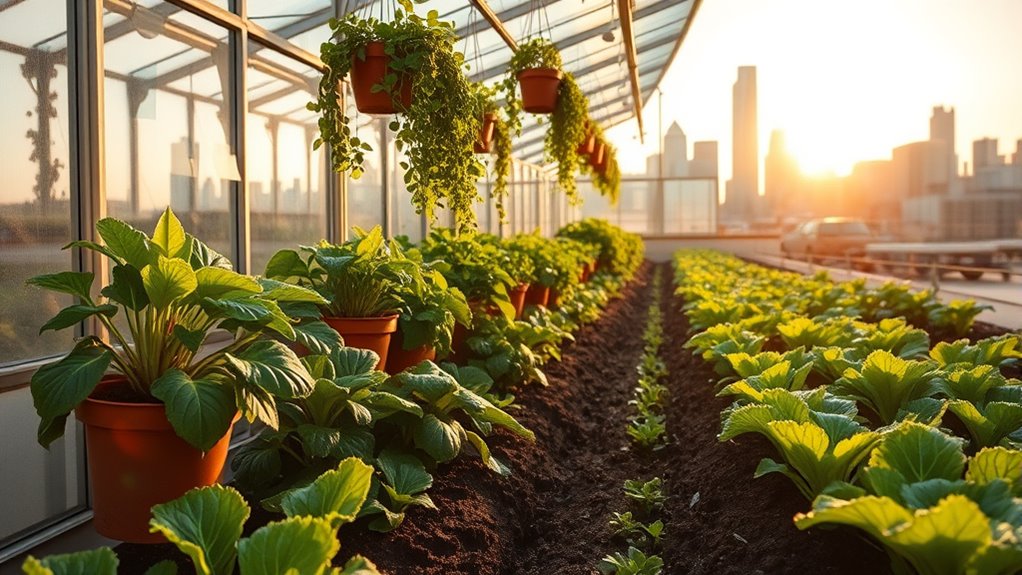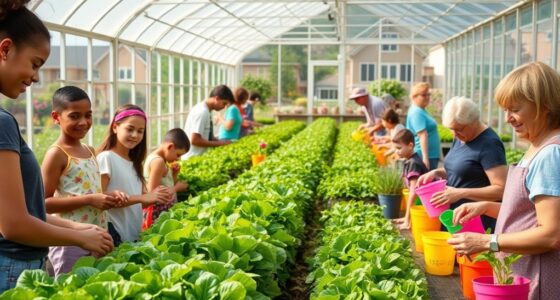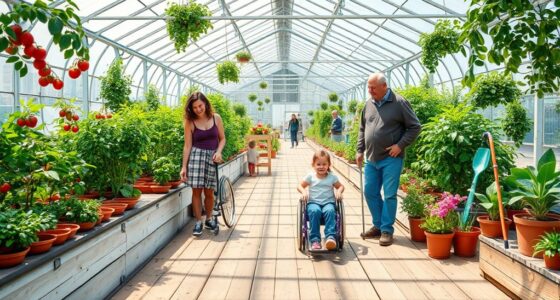Urban greenhouses transform city living by providing fresh, locally-grown produce right at your doorstep. They help combat the heat and improve air quality while fostering biodiversity. With innovative technologies like hydroponics and automation, urban farming maximizes yields and minimizes resource use. Plus, they boost local economies and create job opportunities. You'll find these green spaces not only enhance food security but also strengthen community ties. Discover how these greenhouses are changing urban landscapes for the better!
Key Takeaways
- Urban greenhouses provide fresh, locally grown produce, enhancing food security for city dwellers and reducing reliance on transportation.
- They utilize innovative technologies like hydroponics and IoT sensors to maximize yields and resource efficiency.
- Greenhouses create jobs and stimulate local economies by fostering entrepreneurship in food production and retail.
- By increasing access to fresh foods, urban greenhouses promote community health and well-being.
- They serve as community hubs, offering educational programs on sustainability and encouraging community engagement through gardening initiatives.
Environmental Benefits of Urban Greenhouses
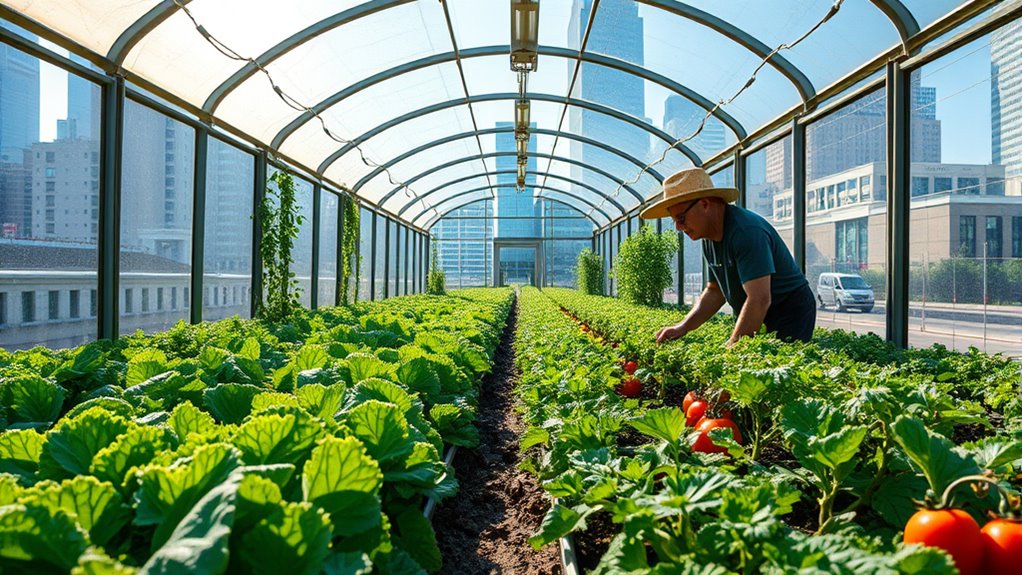
As urban areas continue to grow, you might find that urban greenhouses offer significant environmental benefits that help combat many challenges cities face today. They reduce the urban heat island effect by providing shade and cooling the surrounding air, improving overall comfort. Greenhouses also enhance air quality by increasing oxygen levels and filtering pollutants. Additionally, urban agriculture promotes community engagement by connecting residents to their food sources and nature. By capturing rainwater for irrigation, they manage stormwater effectively, reducing runoff. Furthermore, they can incorporate high-quality equipment for efficient energy use, supporting biodiversity by creating habitats for various plant and animal species. Urban greenhouses cut down carbon emissions associated with food transportation, making them an eco-friendly choice. To further enhance air quality, these systems can utilize advanced filtration systems that help reduce indoor allergens and pollutants. With energy-efficient designs and sustainable practices, they contribute to a healthier urban environment, making cities greener and more livable. Moreover, incorporating sustainable practices into urban greenhouses can lead to improved soil health and increased crop yields.
Innovative Technologies Shaping Urban Agriculture
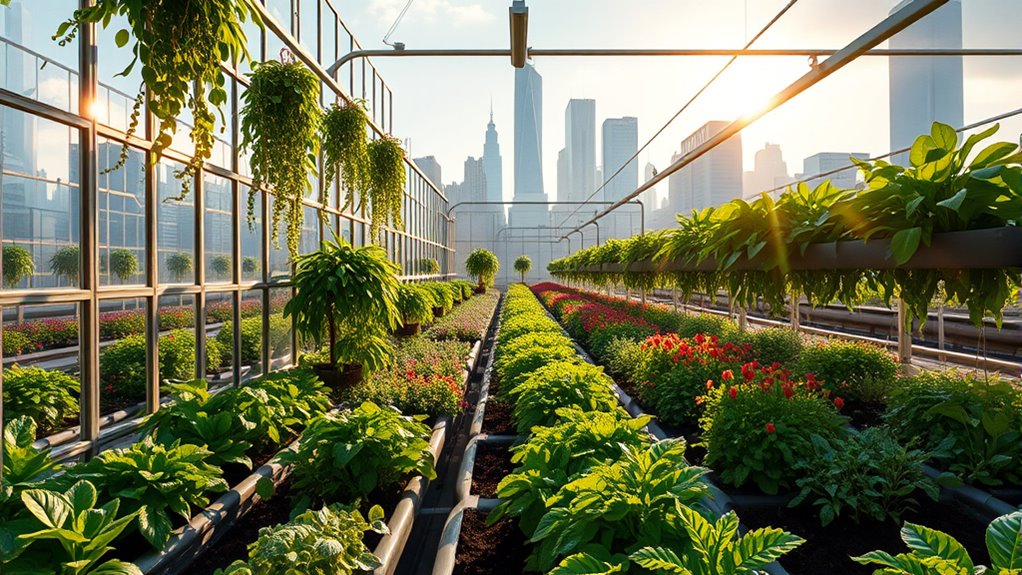
Innovative technologies are transforming urban agriculture by making it more efficient and sustainable. IoT devices and sensors monitor conditions like temperature and humidity, helping you optimize crop growth. With data analytics and AI, you can make informed decisions and predict yields more accurately. Vertical farming allows you to stack crops, maximizing space while enabling year-round production. Moreover, urban agriculture repurposes rooftops and vacant lots for food production, further enhancing sustainability in city environments. Hydroponics and aquaponics use nutrient solutions to grow plants without soil, conserving water and boosting yields. Additionally, risk management strategies can be applied to urban agriculture practices to mitigate potential losses from unforeseen circumstances. Automation and robotics streamline tasks such as planting and harvesting, taking the strain off labor. Additionally, smart farming apps offer real-time monitoring and task scheduling, ensuring you stay on top of your urban farming game. As renewable energy sources continue to advance, they will further reduce the environmental impact of urban agriculture. By implementing essential survival gear, urban dwellers can better prepare for potential food shortages. Embrace these technologies and watch your urban garden thrive!
Economic Advantages for Local Communities
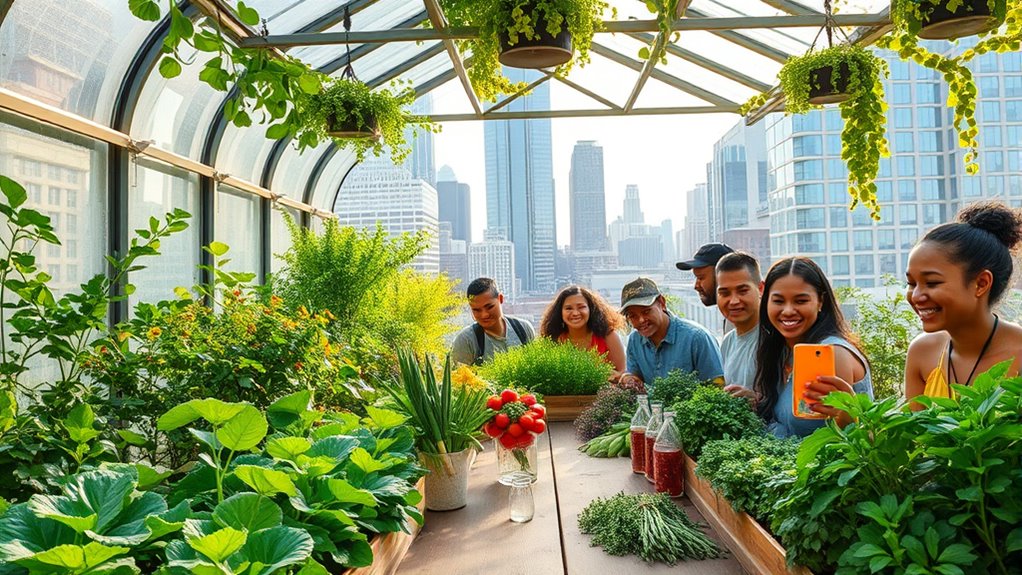
Urban greenhouses aren't just about sustainable farming; they also bring significant economic advantages to local communities. By creating jobs in agriculture, management, and maintenance, urban greenhouses help boost employment. They cut transportation costs by producing fresh produce locally, which stimulates local economies and lowers food expenses for families. As these greenhouses beautify neighborhoods, property values often rise, making areas more desirable. You'll also find entrepreneurial opportunities in food production and retail sales sprouting up as a result. With decreased reliance on seasonal imports, urban greenhouses pave the way for cost-effective year-round food production, keeping more money circulating within your community. Additionally, urban greenhouses act as a catalyst for economic development, enhancing the overall vitality of local neighborhoods. Furthermore, their establishment can lead to lower food expenses as they provide fresh, local produce that reduces the need for costly imports. These initiatives also foster community resilience, empowering residents to take charge of their food sources and build stronger local economies. Moreover, the implementation of urban greenhouses can significantly reduce assisted living expenses by providing affordable and nutritious food options for seniors in the community.
Social Impact and Community Engagement

While you may think of urban greenhouses primarily as sources of fresh produce, they also play an essential role in fostering community engagement and social interaction.
These greenhouses enhance food security by providing local produce and reducing transportation reliance. They often serve as community hubs, inviting you to participate in workshops and educational programs that empower you with knowledge about sustainability and food production. Furthermore, they increase access to fresh, culturally appropriate foods for community members. Additionally, studies show that pet therapy can enhance emotional well-being, highlighting the importance of supportive community interactions. Community gardening initiatives can also create a sense of ownership and pride among residents, leading to a stronger commitment to local green spaces. Establishing clear rules and routines within these greenhouses can help cultivate a more organized and productive environment.
By involving residents in planning and maintenance, urban greenhouses reflect local needs and strengthen neighborhood ties. They also promote cultural preservation through community gardening initiatives, allowing diverse traditions to flourish.
Involving residents in urban greenhouses fosters local connections and celebrates diverse cultural traditions through community gardening initiatives.
Additionally, volunteer opportunities in these spaces encourage intergenerational and intercultural interactions, creating a vibrant community atmosphere where everyone can thrive together.
Overcoming Challenges in Urban Greenhouse Development
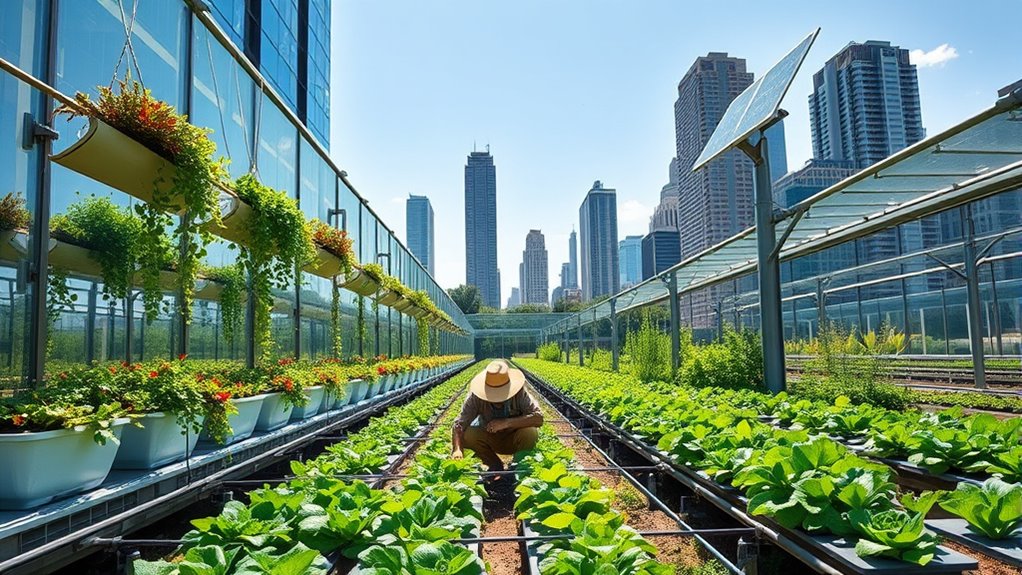
As cities grow and the demand for fresh produce increases, overcoming challenges in urban greenhouse development becomes essential. You'll need to tackle environmental issues like air and soil contamination, adapting to harsh rooftop conditions with specialized growing media. Effective water management, such as rainwater harvesting, is vital for sustainability, especially since mycorrhizae enhance crop resistance to environmental stresses. Additionally, incorporating solar-powered irrigation systems can significantly enhance crop yields and efficiency. To optimize resource use, consider integrating self-directed IRAs that allow for investment in innovative agricultural technologies. Economically, high start-up costs and market competition require innovative business models, like subscription services, to remain viable. Moreover, urban greenhouses can benefit from incorporating chia seeds' high fiber content to improve the nutritional value of the produce grown. Technologically, consider vertical farming and energy-efficient designs to maximize yield and reduce costs. Maneuvering regulatory challenges, including land-use policies and zoning regulations, is critical.
Frequently Asked Questions
What Types of Plants Can Be Grown in Urban Greenhouses?
You can grow a variety of plants in urban greenhouses. Annuals like marigolds and zinnias add color, while perennials such as coneflowers return year after year.
For fresh produce, leafy greens, tomatoes, and cucumbers thrive in controlled environments. Don't forget herbs like basil and mint for culinary needs.
Additionally, consider pollinator-friendly plants to support local ecosystems. Urban greenhouses offer the perfect setting for diverse and productive plant growth.
How Do Urban Greenhouses Affect Local Food Prices?
Did you know that urban greenhouses can reduce transportation costs by up to 50%? They impact local food prices by offering fresher, locally grown produce, appealing to consumers willing to pay more for quality.
Their year-round production helps stabilize prices, while targeting high-end markets allows for premium pricing.
Additionally, some greenhouses implement social pricing models, making fresh food more accessible for underserved communities, enhancing overall food security in urban areas.
Can Urban Greenhouses Operate Without Soil?
Yes, urban greenhouses can operate without soil by using soilless farming methods like hydroponics and aeroponics.
In hydroponics, plants grow in nutrient-rich water, while aeroponics uses a fine mist to nourish the roots. These methods allow you to maximize space and conserve water, producing food efficiently in urban areas.
What Are the Maintenance Requirements for Urban Greenhouses?
Maintaining an urban greenhouse is like juggling flaming swords—every detail matters!
You'll need to conduct regular inspections of frames and systems to catch potential issues early. Adjust your maintenance plan based on the covering type, and keep meticulous repair logs.
Pre-season checks are vital for equipment readiness. Proper ventilation and humidity control are important, while regular pest inspections guarantee your plants stay healthy.
With dedicated staff, you'll create a thriving environment for growth!
How Do Urban Greenhouses Contribute to Climate Change Mitigation?
Urban greenhouses contribute to climate change mitigation by reducing transportation emissions through local food production. They sequester carbon in soil and vegetation, helping to offset greenhouse gases.
By utilizing energy-efficient technologies like hydroponics and LED lighting, they lower their overall carbon footprint. Additionally, urban greenhouses promote biodiversity and enhance community engagement, fostering sustainable practices.
You'll find that these initiatives not only support food security but also bolster urban resilience against climate-related disruptions.
Conclusion
Urban greenhouses are like vibrant oases in the concrete jungle, offering fresh produce and nurturing communities. By embracing innovative technologies and fostering local engagement, these green spaces can transform city life, promoting sustainability and resilience. While challenges exist, the benefits far outweigh the hurdles. You have the power to support this movement, ensuring that urban dwellers enjoy the bounty of fresh food, all while contributing to a greener, healthier environment for generations to come.
